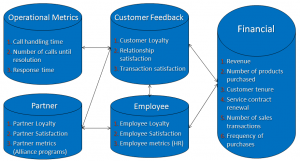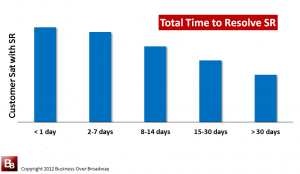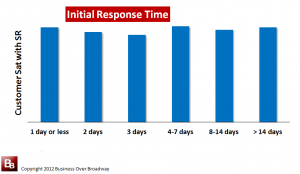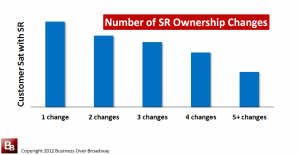
Data Silo for each Business Data Source
Customer experience management (CEM) programs are no stranger to the use of data. CEM professionals use data to gain insight about their customers to help improve the customer experience and optimize customer loyalty. Not surprisingly, CEM programs typically rely on customer feedback as their main data source (e.g., social media, customer emails, tech support notes, formal customer surveys). Customer feedback data, however, are only one type of business data that are used to improve business decisions.
Big Data
The concept of Big Data is broad one and I consider it an amalgamation of different areas that help us try to get a handle on, insight from and use out of data. Big Data, including the tools, processes and solutions to wrangle the ever-increasing size, complexity and velocity of business data, can help companies extract value from collecting, processing and analyzing vast quantities of data. Businesses who can get a better handle on these data will be more likely to outperform their competitors who do not.
I recently wrote about the implications of Big Data on the practice of CEM and how Big Data providers can help companies integrate all their different business data (e.g., operational, financial, constituency, customer) to understand how different data sources impact customer satisfaction and loyalty. With the ever-increasing hype around the promise of Big Data, there has been a call for practitioners to provide real world examples of Big Data solutions in use. I offer up one example below. The example was first presented in my book on CEM best practices, Beyond the Ultimate Question, and highlights Oracle’s use of Big Data principles to improve their service request (SR) process.
Oracle Understands Value of Integrating Data Silos
Jeb Dasteel, Oracle’s senior vice president and chief customer officer, understands the value of integrating different data sources with their customer metrics:
“It is important to understand how the operational measures that we use to drive our business correlate to the satisfaction of our customers. Our studies have helped determine the areas of operational performance that are the key drivers of our customer’s satisfaction. This has provided an opportunity to focus our improvement initiatives specifically on those areas that are of greatest importance to our customers.”
Jeb Dasteel, SVP, Chief Customer Officer, Oracle
from, Beyond the Ultimate Question
By integrating different types of metrics (from disparate data silos), Oracle is able to expand how they think about their customer experience improvement initiatives. Rather than focusing solely on their customer metrics to gain customer insights, Oracle links different data sources to get a holistic understanding of all the business areas that impact customer loyalty. Here is how they accomplished this Big Data project.
Oracle’s Service Request Process
Oracle customers can request help in the form of service requests (SRs). The quality of these SRs are typically measured using objective operational metrics that are automatically generated in their CRM system. Oracle’s system tracks many operational metrics. For this illustration, we will look at three:
- Total Time to Resolve (Close Date – Open Date)
- Initial Response Time
- Number of SR Ownership Changes
In addition to the operational metrics that are captured as part of their SR process, Oracle solicits feedback from their customers about the quality of their specific SR experience (via transaction-based survey). These customer feedback data are housed in a separate system apart from the operational metrics.
Oracle wanted to understand how their operational metrics were related to satisfaction with the service request.
Data Federation of Operational Metrics and Customer Metrics

Figure 1. Data Model for Linking Operational Metrics and Customer Metrics (result of data federation)
Oracle used data federation to pull together metrics from the two disparate data sources (operational metrics and one for customer satisfaction metrics). The data were linked together at the transaction level. The data model for this Big Data project appears in Figure 1.
After the data were linked together, segments for each operational variable were created (from low to high values) to understand how customer satisfaction varied over different levels of the operational metric.
Results of Analyses
Analyses revealed some interesting insights about how the three operational metrics impact customer satisfaction with the transaction. The relationship of each operational metric with overall satisfaction with the SR is presented in Figures 2, 3 and 4.
Using Total Time to Resolve the SR, Oracle found that customers were more satisfied with their SRs that were resolved more quickly compared to customers whose SRs took longer to resolve (See Figure 2.).
Using Initial Response Time to the SR, Oracle found that customers were no more satisfied or dissatisfied with their SRs whether the initial response time was fast or slow (See Figure 3.). Despite the expectations that the Initial Response Time to the SR would greatly impact the customers’ satisfaction with the SR, this study showed that the initial response time had no impact on the satisfaction of customers.
Using Number of Ownership Changes, Oracle found that customers were more satisfied with their SRs that had fewer ownership changes compared to customers whose SRs had more ownership changes (See Figure 4.).
The application of Big Data solutions at Oracle has provided much insight regarding how the management of customers through the Service Request process can be facilitated with the use of operational metrics. The analyses showed that not all operational metrics are predictive of customer satisfaction; initial response time was unrelated to customer satisfaction, suggesting that monitoring metrics associated with that aspect of the SR process is unnecessary in improving customer satisfaction. To improve the customer experience with the SR process (e.g., improve customer satisfaction), changes to the SR process are best directed at elements of the SR process that will impact the resolution time and the number of ownership changes.
Benefits of Big Data
Linking disparate data silos proved useful for Oracle. They were able to identify the operational metrics that were important to customers. More importantly, they were able to identify operational metrics that were not important to driving customer satisfaction. Demonstrating the statistical relationship between operational metrics and customer satisfaction and operational metrics can help you in three ways:
- Build/Identify customer-centric business metrics: You can identify/create key operational metrics that are statistically linked to customer satisfaction and focus only those that are important to your customers.
- Manage customer relationships using objective operational metrics: Driving business growth now becomes a process of using the operational metrics to manage customer relationships. Big Data studies can help you identify appropriate operational performance goals (using operational metrics) that ensure customers will be satisfied.
- Reward employee behavior that will drive customer satisfaction: Because of their reliability and specificity, operational metrics are good candidates for use in goal setting and employee incentive programs. Rewarding employee performance based on customer-centric operational metrics ensures employees are aligned with the needs of the customers.
Summary
Proper application of Big Data principles helps expand the types of metrics you can use as part of your customer experience strategy. By taking a customer-centric approach in their analyses of their Big Data, Oracle was able to link operational metrics to customer feedback metrics to identify how the operational metrics are related to customer satisfaction. This type of approach to understanding all your business data will help you build customer-centric operational metrics, manage customer relationships using operational metrics and reward employees based on operational metrics that matter to the customer.






